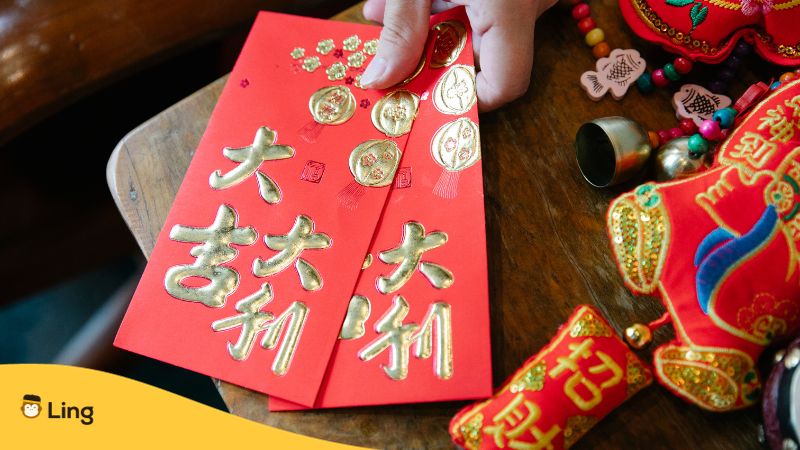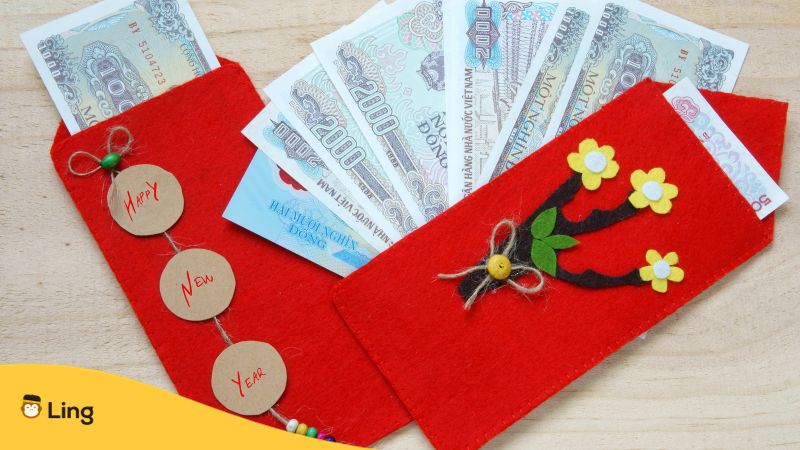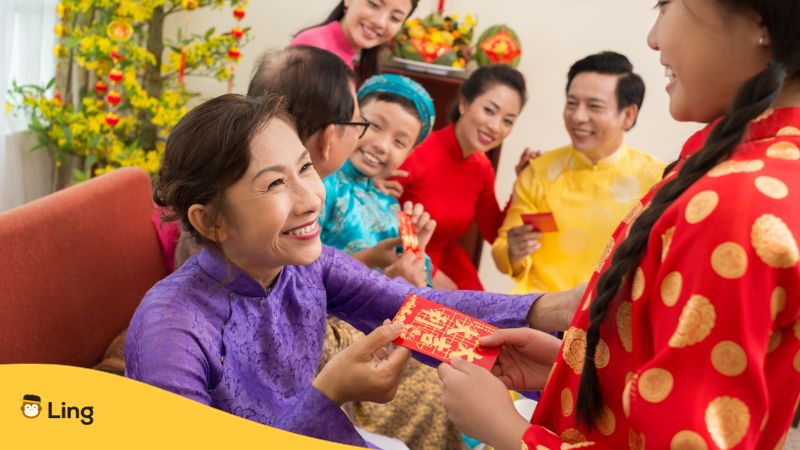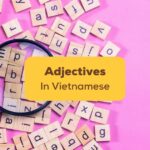Cue the Chinese drums and dragon flames, people! When those red and gold banners start swaying through Chinatown, you know the Lunar New Year festivities have arrived. Time to ring in the Year of the Wood Dragon in true Tsinoy style. We’re talking non-stop feasts, deafening fireworks, and MLS-level scrambles for ang pao or little red envelopes.
What’s the deal with Filipino-Chinese folks and these cute scarlet pouches being passed around like hotcakes during the holidays? It’s not just kids hoping for some quick candy money from their doting elders. The ancient ang pao tradition symbolizes wishes for prosperity and luck in the coming year.
Origins can be traced back to China, but Tsinoys have embraced the custom over generations in the Philippines – with some unique local twists. From proper ritual etiquette to scoring the biggest ang pao money stash, we’re breaking down everything you need to know before joining the red envelope frenzy in the country!
Table Of Contents

What Is Ang Pao?
At its core, an ang pao (pronounced as ang pow) refers to a tiny red envelope or bag filled with money and gifted during the Lunar New Year and other Chinese holidays like weddings or birthdays. You’ll often spot the auspicious hue and gold accents adorning these little packets. The origin of its name comes from the Hokkien Chinese phrase “ang pau,” directly translating to “red envelope” – “ang” meaning red and “pau” meaning package. Some regions may refer to it by other names like hongbao in Mandarin or lai see in Cantonese, but the idea remains the same.
The red color bears great cultural significance for Chinese communities like the Tsinoys. It symbolizes luck, prosperity, and warding off evil spirits or bad fortune – very fitting for the optimistic start of a New Year. Even beyond the color symbolism and money aspect, ang paos represent blessings for the future and the gift of life’s opportunities in the coming days.
While kids get excited to snag these little pockets for the cold, hard cash inside, traditionally, you don’t politely open and count your ang pao in public right after receiving it. Part of Filipino etiquette is recognizing the symbolic meaning rather than focusing solely on the monetary amount gifted.
History Of Ang Pao
The origins of gifting ang paos can be traced back thousands of years to the Sung Dynasty in China. At a time when coins were the currency, wealthy Chinese families would distribute these coins in silk pouches during festive occasions as a symbolic gift. This eventually evolved into the paper envelopes filled with money that we know today.
The tradition carries great cultural importance for Tsinoys in particular, as they brought ang pao customs with them when Chinese traders and migrants originally settled in the Philippines centuries ago during the Spanish colonial period.
Over generations, Tsinoys have preserved various Chinese holiday celebrations, including Lunar New Year festivities centered around food, family, and of course – the obligatory ang paos. Elders gift these little red envelopes not just to children but also to unmarried adults to promote their good fortune in finances and love lives for the coming year.
Beyond symbolizing hopes for prosperity and luck, the act of gifting ang paos represents the importance of familial ties in Tsinoy culture. The money isn’t as valued as much as the meaning behind the gesture. Parents, grandparents, and respected elders pass down ang paos to the next generation as a symbolic blessing.
The tradition strengthens bonds between young and old while conveying wishes for their future success. And kids know to show respect through the mano ritual – clasping their elders’ hands in thanks – upon receiving these little red gifts.

How Much Money To Put Inside An Ang Pao
You may be wondering, what’s the appropriate amount to put inside one of those little red envelopes? The specifics often depend on the recipient’s age and the giver’s financial situation. But there are general ang pao etiquette rules that Tsinoys follow.
For kids, unmarried teens/young adults are usually gifted anywhere from 100 to 1,000 pesos inside each ang pao. The standard minimum at Lunar New Year celebrations is about 100-200 pesos. Of course, doting grandparents or richer aunties may stuff 1,000 or more as a bigger blessing!
The amount tends to scale up for older unmarried adults, newlyweds, or godchildren – ranging from 500 to 2,000 pesos. Again, some families distribute up to 3,000 pesos for milestone ages like 18th or 21st birthdays. Relatives and godparents may gift anywhere from 2,000 to 10,000 pesos in ang paos at weddings to bless the newlyweds.
For employees in Tsinoy-owned companies, owners traditionally hand out ang pows with a 500 minimum, but monthly salaries determine how much extra they add.
The bottom line is while the money itself matters, the symbolic luck and prosperity wish to hold deeper meaning. So Tsinoys emphasizes that politeness calls for gratefully accepting – not blatantly comparing or commenting on ang pao amounts.
Where To Buy Ang Pao In The Philippines
Want to join in on the Lunar New Year fun or decorate with some ang pao envelopes yourself? Luckily, you can find these decorative red packets sold affordably at stores across metro Manila as the holidays approach.
In Chinatown districts like Binondo and Ongpin Street, street vendors and Chinese grocery stores stock various ang pao styles, typically priced from 15 to 50 pesos each. The envelope sizes and designs tend to come in bulk packs, ideal for gifting money to multiple people. Popular mall chains like National Bookstore and SM Department Store also carry ang pao card packs around the same price range. These make gifting organization easier, with multiple envelopes handy.
The best time to shop for these seasonal ang paos is in the months of December to early February leading up to the Lunar New Year. Chinese stores and markets stock their shelves full of red envelopes galore for eager Tsinoys preparing gifts of prosperity!

What To Say When Receiving Ang Pao
Part of ang pao etiquette is knowing how to politely accept your little red envelopes or risk missing out on the gifts of cash. Make sure to have these Tagalog phrases handy when mano-ing elders at your next Lunar New Year celebration or scoring a wedding red packet:
- “Salamat po!” – The classic way to say “Thank you” and show gratitude when an elder hands you an ang pao. Pop in a small mano hand gesture too.
- “Ang swerte ko po!” – Translates to “I’m so lucky!” for when you want to enthusiastically convey appreciation for the generous ang pao gift.
- “Maligayang Bagong Taon po!” – Means “Happy New Year!” Perfect for the Lunar NY celebration when greeting your Tsinoy elders or friends distributing ang paos.
- “Masaganang bagong taon sa inyong lahat!” – Say this lively blessing which means “Abundant new year to you all!” to wish everyone prosperity in the coming days.
Of course, it’s fine to stick to English greetings or personal messages, too, when your Tagalog vocabulary needs a boost! The sincerity and smile are what matter most when receiving your little red envelopes stuffed with good wishes.
Over To You
Beyond just getting in on the holiday cash action, ang paos represent blessings for luck and prosperity in the coming year. They strengthen the bonds between young and old through a meaningful gesture powered by hope for the future.
So the next time you wander through Chinatown and spot little kids eagerly tearing open red packets, you’ll know the significance behind the scramble. Here’s wishing everyone good fortune in wealth, love, and happiness in the Year of the Dragon! Kung Hei Fat Choi, and may your own ang paos overflow with blessings!
Want to learn more about the Philippines and the Tagalog language? Give Ling a try today to start learning the right way! Download it for FREE from the App Store or Play Store now!



































































